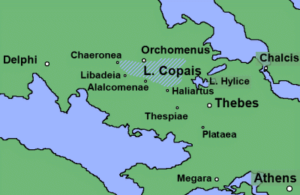David Windell
Scranton, Robert Lorentz
Robert Lorentz Scranton (1912-1993) was an American professor of Classical Art at the University of Chicago. He was the author of Greek Walls[1223] in which he endeavoured to develop a stylistic classification system of walls that might assist chronological sequencing.
the author of Greek Walls[1223] in which he endeavoured to develop a stylistic classification system of walls that might assist chronological sequencing.
He wrote a short article(c) with the daring title of “Lost Atlantis  Found Again?” in which he suggests the possibility that Atlantis had been located in Lake Copaïs in Boeotia, Greece. The area is rich in ancient remains including that of a number of canals. However, Scranton was somewhat unsettled by the fact that Plato had described Atlantis as being in the Central Mediterranean, to the west of both Athens and Egypt (see Crit.114c & Tim.25a/b).
Found Again?” in which he suggests the possibility that Atlantis had been located in Lake Copaïs in Boeotia, Greece. The area is rich in ancient remains including that of a number of canals. However, Scranton was somewhat unsettled by the fact that Plato had described Atlantis as being in the Central Mediterranean, to the west of both Athens and Egypt (see Crit.114c & Tim.25a/b).
Scranton’s 1949 article was subsequently made available on Oliver D. Smith’s website(a). Scranton’s Atlantis theory had elements in common with that of Smith’s, who abandoned his Atlantis theory some years ago in favour of a sceptical view of Plato’s narrative.
Joannes Richter, the Dutch linguist, has published a paper, The War against Atlantis, in which he also looks at the idea that Lake Copaïs may have inspired elements of the Atlantis story.
In recent years, excavations in the Lake Copaïs region have revealed more extensive ancient remains than anticipated(b).
A 2021 paper by Therese Ghembaza and David Windell noted that “Since the draining of Lake Copais in Boeotia in the late 19th century archaeological research has revealed Bronze Age hydraulic engineering works of such a scale as to be unique in Europe. Starting in the Middle Helladic period with dams, dikes and polders, the massive extension of the scheme in the Late Helladic period, with large canals and massive dikes, achieved the complete drainage of the lake; a feat not achieved again, despite Hellenistic attempts, until the 20th century.” (d)
An annual Robert L. Scranton Lectureship was established in 1999.
(a) https://atlantisresearch.files.wordpress.com/2013/12/lost-atlantis-found.pdf (now offline – see entry for Oliver D. Smith) See: (c) below
(b) https://popular-archaeology.com/issue/summer-2016/article/rediscovering-a-giant1
(c) Archaeology 2, 1949, p159-162 https://www.jstor.org/stable/i40078396
